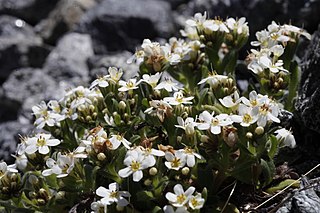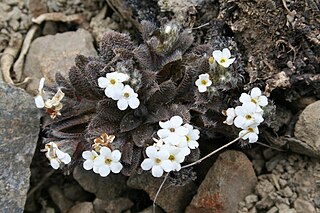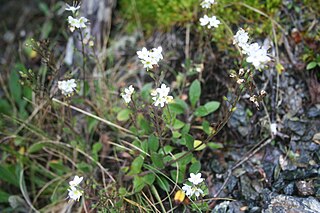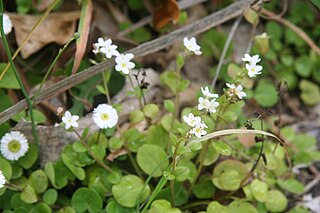
Myosotis antarctica is a species of flowering plant in the family Boraginaceae, native to mainland New Zealand, Campbell Island and southern Chile. Joseph Dalton Hooker described the species in his 19th century work Flora Antarctica. Plants of this species of forget-me-not are perennial with a prostrate habit, bracteate inflorescences, and white or blue corollas. It is one of two native species of Myosotis in the New Zealand subantarctic islands, the other being M. capitata, which also has blue corollas.

Myosotis albiflora is a species of flowering plant in the family Boraginaceae, native to southern Chile and Argentina. This species was described by Joseph Banks and Daniel Solander in Joseph Dalton Hooker's 19th century work Flora Antarctica. Plants of this species of forget-me-not are perennial and have white corollas. It is one of two native species of Myosotis in southern South America, the other being M. antarctica.

Myosotis lyallii is a species of flowering plant in the family Boraginaceae, endemic to New Zealand. Joseph Dalton Hooker described the species in 1853. Plants of this species of forget-me-not are perennial with a prostrate habit, bracteate or partially-bracteate inflorescences, and white corollas.

Myosotis lyalliisubsp. elderi is a subspecies of flowering plant in the family Boraginaceae, endemic to New Zealand. Lucy Moore described Myosotis elderi in 1961, and Heidi Meudt and Jessie Prebble treated it as a subspecies of M. lyallii in 2018. Plants of this subspecies of forget-me-not are perennial with a prostrate habit, bracteate inflorescences, and white corollas with partially exserted anthers.

Myosotis lyalliisubsp. lyallii is a subspecies of flowering plant in the family Boraginaceae, endemic to the South Island of New Zealand. Joseph Dalton Hooker described M. lyallii in 1853. Plants of this subspecies of forget-me-not are perennial with a prostrate habit, bracteate or partially-bracteate inflorescences, and white corollas, usually with exserted anthers.

Myosotis brockiei is a species of flowering plant in the family Boraginaceae, endemic to southern South Island of New Zealand. Lucy Moore and Margaret Simpson described the species in 1973. Plants of this species of forget-me-not are perennial rosettes which form loose tufts or clumps, with ebracteate, erect inflorescences, and white corollas with exserted stamens.

Myosotis brockieisubsp. brockiei is a subspecies of flowering plant in the family Boraginaceae, endemic to southern South Island of New Zealand. Lucy Moore and Margaret Simpson described M. brockiei in 1973. Plants of this subspecies of forget-me-not are perennial rosettes which form caespitose tufts or clumps, with ebracteate, erect inflorescences, and white corollas with exserted stamens.

Myosotis brockieisubsp. dysis is a subspecies of flowering plant in the family Boraginaceae, endemic to southern South Island of New Zealand. Shannel Courtney and Heidi Meudt described this subspecies in 2021. Plants of this subspecies of forget-me-not are perennial rosettes which form stoloniferous mats, with long, ebracteate, erect inflorescences, and white corollas with exserted stamens.

Myosotis goyenii is a species of flowering plant in the family Boraginaceae, endemic to the South Island of New Zealand. Donald Petrie described the species in 1891. Plants of this species of forget-me-not are perennial rosettes which form loose tufts or clumps, with ebracteate, erect inflorescences, and white corollas with partly exserted or fully included stamens.

Myosotis goyeniisubsp. goyenii is a subspecies of flowering plant in the family Boraginaceae, endemic to southern South Island of New Zealand. Donald Petrie described the species M. goyenii in 1891. Plants of this subspecies of forget-me-not are perennial rosettes which form loose clumps, with ebracteate, erect inflorescences, and white corollas with partly exserted stamens.

Myosotis goyeniisubsp. infima Meudt & Heenan is a subspecies of flowering plant in the family Boraginaceae, endemic to central South Island of New Zealand. Heidi Meudt and Peter Heenan described this subspecies in 2021. Plants of this subspecies of forget-me-not are perennial rosettes which form caespitose clumps, with ebracteate, erect inflorescences, and white corollas with fully incluced stamens.

Myosotis traversii is a species of flowering plant in the family Boraginaceae, endemic to the South Island of New Zealand. Joseph Dalton Hooker described this species in 1864. Plants of this species of forget-me-not are perennial rosettes which form tufts or clumps, with ebracteate, erect inflorescences, and white or yellow corollas with partly exserted stamens.

Myosotis traversiisubsp. cantabrica is a subspecies of flowering plant in the family Boraginaceae, endemic to the central South Island of New Zealand. Lucy Moore described M. traversii var. cantabrica in 1961 and Heidi Meudt changed its rank to subspecies in 2021. Plants of this subspecies of forget-me-not are perennial rosettes which form tufts or clumps, with ebracteate, erect inflorescences, and white or yellow corollas with partly exserted stamens.
Myosotis × cinerascens is a hybrid species of flowering plant in the family Boraginaceae, endemic to the South Island of New Zealand. Donald Petrie described M. cinerascens in 1891, and it was later deemed to be a hybrid in 2021. Plants of this forget-me-not are perennial rosettes which form tufts or clumps, with ebracteate, erect inflorescences, and white corollas with partly exserted stamens.

Myosotis hikuwai is a species of flowering plant in the family Boraginaceae, endemic to the South Island of New Zealand. Heidi Meudt, Jessica Prebble and Geoff Rogers described M. hikuwai in 2022. Plants of this forget-me-not are spring annuals with bracteate and erect inflorescences, and small, white corollas with inserted stamens. The species is considered Threatened and known only from one population near Wānaka.

Myosotis pansa subsp. praeceps is a subspecies of flowering plant in the family Boraginaceae, endemic to the North Island of New Zealand. Lucy Moore described the variety M. petiolata var. pansa in 1961, and it was transferred to a subspecies of M. pansa by Heidi Meudt, Jessica Prebble, Rebecca Stanley and Michael Thorsen in 2013. Plants of this species of forget-me-not are perennial rosettes with partially bracteate inflorescences and white corollas with exserted stamens.

Myosotis exarrhena is a species of flowering plant in the family Boraginaceae, endemic to Australia. Robert Brown described this species as Exarrhena suaveolens in 1810. Plants of this species of forget-me-not are perennial rosettes with ebracteate inflorescences and white corollas with exserted stamens.

Myosotis saxatilis is a species of flowering plant in the family Boraginaceae, endemic to New Zealand. Donald Petrie described this species in 1918. Plants of this species of forget-me-not are perennial rosettes with ebracteate inflorescences and white corollas with stamens that are fully included in the corolla tube or sometimes partly exserted.

Myosotis australis is a species of flowering plant in the family Boraginaceae, native to New Zealand, Australia and New Guinea. Robert Brown described this species in 1810. Plants of this species of forget-me-not are perennial rosettes with ebracteate inflorescences and white or yellow corollas with stamens that are fully included in the corolla tube or sometimes partly protruded.

Myosotis australissubsp. australis is a subspecies of flowering plant in the family Boraginaceae, native to New Zealand and Australia. Robert Brown described M. australis in 1810. Plants of this subspecies of forget-me-not are perennial rosettes with ebracteate inflorescences and white or yellow corollas with stamens that are fully included in the corolla tube or sometimes partly protruded.

















